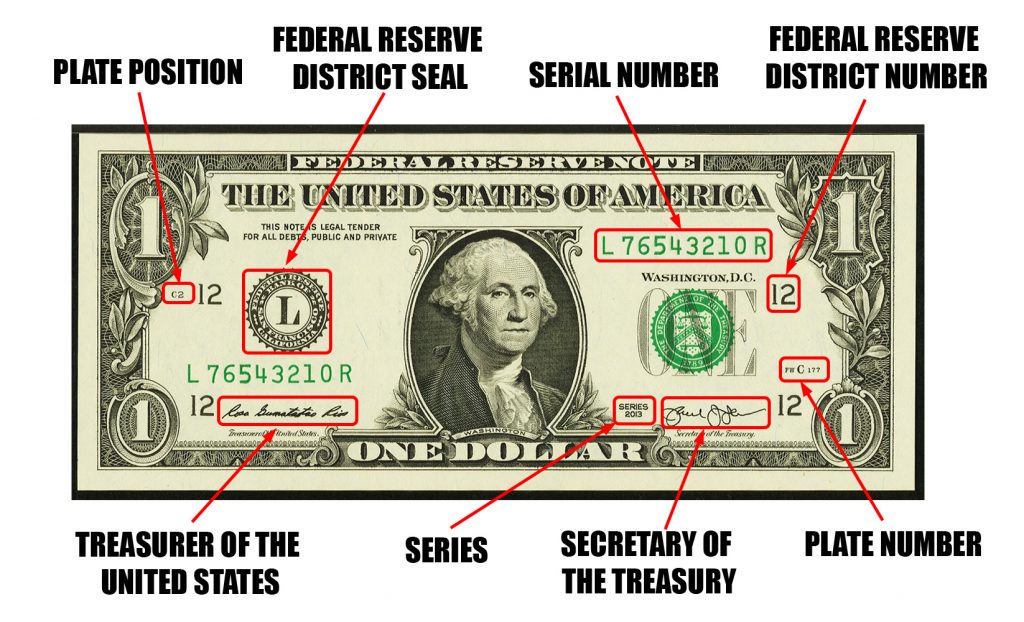TLDR
Serial numbers are supposed to be unique. The Bureau of Engraving and Printing accidentally printed duplicate serial numbers for some $1 2013 star notes. The range of serial numbers that were duplicated are as follows:
B 0000 0001 * - B 0025 0000 *
B 0320 0001 * - B 0640 0000 *
B 0640 0001 * - B 0960 0000 *
If you want to check if someone has a match, you can download the most recent version of the spreadsheet here: October 2021 spreadsheet.
First Some Background
Where is paper money printed?
It is a common (but incorrect) assumption that the federal reserve bank of the note is also where it is printed. Paper money in the United States is actually printed in two locations - Washington DC and Fort Worth, TX. Notes are then sent to any of the 12 federal reserve banks, then distributed into circulation through places like banks.
Serial numbers
Under normal circumstances each serial number + series + denomination is unique - only used a single time.
What happened?
In late 2014, the Bureau of Engraving and Printing (Washington DC facility) printed three star note runs for the New York "B" district. Nothing special about it. They printed these serial number ranges:
Printed in Washington DC
B 0000 0001 * - B 0025 0000 * (October 2014)
B 0320 0001 * - B 0640 0000 * (November 2014)
B 0640 0001 * - B 0960 0000 * (November 2014)
A year and a half later, the Bureau of Engraving and Printing (this time the Fort Worth facility) printed three more star note runs for the New York "B" district. They printed these serial number ranges:
Printed In Fort Worth
B 0000 0001 * - B 0320 0000 * (June 2016)
B 0320 0001 * - B 0640 0000 * (June 2016)
B 0640 0001 * - B 0960 0000 * (July 2016)
As you can see, there are a lot of overlapping numbers. This is never supposed to happen, and why you might've seen a message like Multiple Matching Runs Found in your Star Note Lookup results.
To be clear, these are the serial numbers that have duplicates:
B 0000 0001 * - B 0025 0000 *
B 0320 0001 * - B 0640 0000 *
B 0640 0001 * - B 0960 0000 *
How To Identify Which Run Your Note Is from
You need to know which printing facility your note came from. Luckily it is easy to determine. On the front of the note, find the plate number in the bottom right corner:

If you see "FW" it means your note was printed in Fort Worth, TX. If you do NOT see "FW" it was printed in Washington DC. Easy!
If you are buying one of these star notes on ebay, it is very important to verify where the note was printed - especially for serial numbers in the range of B 0000 0001 * - B 0025 0000 *. Notes that were printed in Washington DC are from a run of 250,000 notes. Notes that were printed in Fort Worth, TX are from a run of 3,200,000 notes. The DC notes are much more rare.
I've seen listings on ebay claiming their note is from the rare run when in reality it is from the more common run. Buyer beware.
Are these notes extra valuable due to the printing mistake?
No - this printing mistake does not augment the value of these star notes. However, some collectors are trying to find matching pairs. For example, they have the B03223412* serial number (printed in Washington DC). They're looking to find the B03223412* that was printed in Fort Worth. The odds of finding these pairs are atomically small, which makes it especially interesting to collectors.
How hard is it to find a matching pair?
A quick google indicates there are about 12 billion one dollar bills in circulation. The pool of notes with these duplicate serial numbers is 13.3 million. Extremely roughly speaking, 1 out of every 1,000 dollar bills in circulation is from this serial number range. Finding a single one of these notes is not particularly hard, especially if you search lots of circulated money. Stumbling across the matching serial number is where it gets interesting.
Say you really want to find a matching pair of these serial numbers by searching ebay listings. Lets set up a theoretical scenario to determine the odds.
- There are 13,300,000 of these notes in circulation
- I have 100 $1 2013 B star notes in my collection that possibly have a match
- 5 new qualifying star notes are listed on ebay each day
Every day, I check those serial numbers from ebay to see if any of them match my 100 notes. Given that, what are the odds of finding at least one match each day?
Variables
- n = 13,300,000 = number of these specific star notes in circulation
- x = 100 = number of these specific star notes in my collection
- z = 5 = number of new notes to check against per day
After a quick statistics refresher course here's what I arrived at:


That works out to a 0.003% chance of finding at least one matching serial number per day. Good luck!
What if you searched this way for a year? Z becomes 1825 (5*365). Your chance of finding at least one matching serial number over the course of a year is 1.36%. Again, if you have 100 in your collection, if there are 5 new listings per day.
Disclaimers
I think this is correct (enough) but definitely could be wrong. Anyone with knowledge of statistics who things differently - please let me know.
There are certainly fewer than 13.3 of these notes in circulation. Some are in my collection, some are in yours, etc. Some have been lost or destroyed already.
Please do not contact me for appraisal requests.
They will be ignored and/or deleted. I receive too many to handle. Read the article "What Is My Note Worth?" to learn how to determine your note's value.